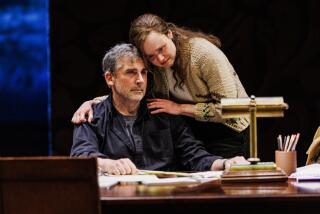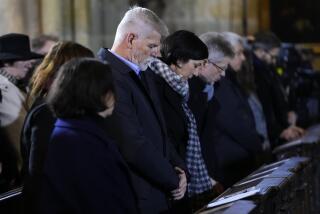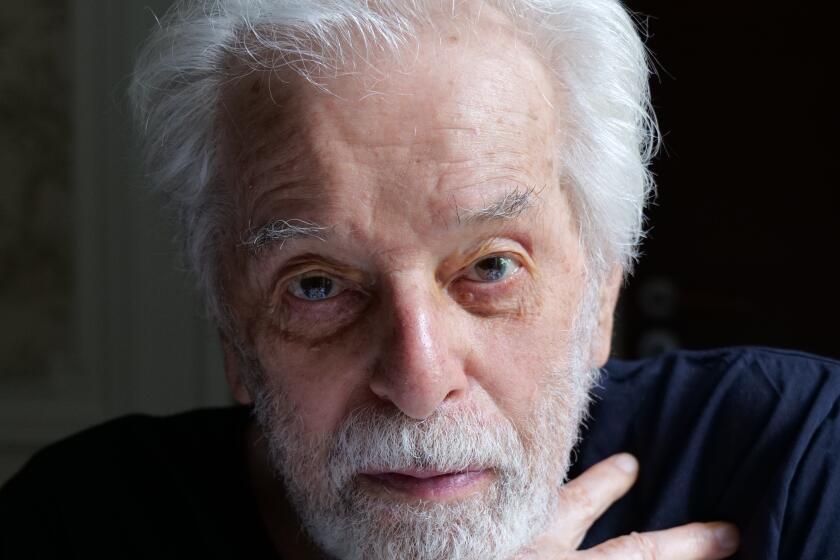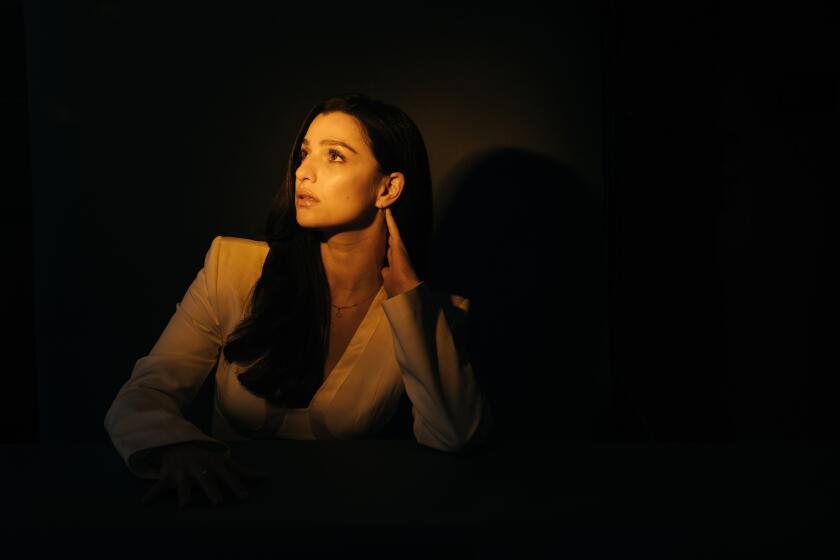Smiles Are Back in Mozart’s Prague
It seems altogether fitting that the film “Amadeus” was shot in this unbelievably gorgeous city, since Mozart dearly loved 18th-Century Prague. Its people gratefully returned his affection by their enthusiastic reception of “The Marriage of Figaro.” In addition, “Don Giovanni” premiered here in 1787.
On any scale of comparison, Prague is surely one of Europe’s half-dozen most beautiful towns, more of a Mozart city with its fanciful confection of Gothic, Baroque and Jugendstil (Viennese art nouveau ) architecture than of native son Franz Kafka’s introspection and melancholia.
Today’s Prague is enjoying its longest springtime in memory, one that began in the winter of 1989 when the “velvet revolution” began to unfurl and release the country from a 44-year-old nightmare of Communist rule. People are smiling again; flower kiosks on Wenceslas Square are abloom with daffodils and forsythia. The city’s storied beer halls are again happy gathering spots for students and intellectuals, and the hottest running ticket in town is “Opera Mozart,” a melange of his works performed with great wit and charm in an old palace overlooking the soft lights of Charles Bridge and Prague Castle across the river.
This upbeat look to the future began with hordes of people chanting “Havel to the castle” before the playwright’s election as Czech president. Unlike former rulers, he shunned residence in the castle and continued to make his digs in a modest apartment after the election, keeping a very close and special relationship with his people in a weekly, no-nonsense radio program discussing the country’s problems.
Such problems include the trauma of privatization, during which just about everything--from small pastry shops to hotel chains--are shedding the yoke of government ownership. If smiles are broad and service brisk, one can bet that the change already has taken place.
The best place to get a quick finger on the pulse of Prague is in one of its many traditional beer halls, roughly akin to a Paris bistro, Vienna coffeehouse and Spanish tapas bar, all rolled into one as an adjunct living-dining room for every level of society. Unlike a Munich hofbrau , you won’t find customers mounting a table with lamp shade and ukulele for an impromptu solo. Yet the air is decidedly lighter now, discussions more animated than when we first visited more than two decades ago.
U Fleku Brewery served up its first glass of dark and heavenly suds in 1499. Its half-dozen cavernous rooms and bosky courtyard are still alive with locals young and old, enough of whom speak English sufficiently to brief you on what’s happening in town.
Approximately 473 spires of every size and style rise to the sky in Prague, many lighted at night, and the effect is spellbinding. A walk along the banks of the Vltava River and across the Charles Bridge in the evening, or a sojourn into the street markets that turn cobbled squares into lively enclaves of capitalism at its best could convince anyone to change their airline tickets for another few days’ stay.
Czechs may have gone through dark and joyless decades since World War II. But they never lost their fondness for la vie boheme , and they delight in sharing their version of it now with anyone from west of their borders. There’s more than enough of it to go around in Prague.
How long/how much? Give Prague at least two days, better three, plus another one or two for visiting a few of the country’s castles (about 4,000 in all) around Prague, or runs to the famous spas of Marienbad and Karlsbad, about 100 miles west. Lodging costs are moderate, although the choice is fairly narrow. But dining is laughably inexpensive.
Getting settled in: Everyone says that U Tri Pstrosu (The Three Ostriches) is Prague’s best and most delightful small hotel. What is left unsaid is that it’s practically impossible to book (40 requests daily from the United States alone), and the staff is a bit wearied by it all. Still, the 1597 building at the foot of the Charles Bridge just oozes atmosphere from every leaded window, beamed or vaulted ceiling. Short of staying at The Three Ostriches, stop in for a meal in its charming restaurant, once a hangout for Prague’s intellectuals.
Hotel Europa still has a great location on Wenceslas Square, plus the aura of pure 19th-Century opulence, albeit a bit faded and worn now. Price and convenience are the attractions here, to go with crystal chandeliers, old paintings, stained-glass windows and ornate vases in the lobby. Just don’t expect sparkle or big-hotel amenities.
Interhotel Pariz, a pleasing mix of fin de siecle , neo-Gothic and art nouveau , is now a national cultural monument. We were enchanted by the mirrored dining room with its mosaic columns, Vienna-style coffeehouse and an air of well-being styled for prosperous burghers. Bedrooms are contemporary, complete with refrigerator, TV and bright baths, and some have bay windows.
Regional food and drink: Czech food is in the main Central-European heavy, which means plenty of pork, knedliky (bread dumplings), goose, duck, hearty sausages, soups and stews, plus sauerkraut and almost as much goulash as you’ll find in Hungary. For a splurge, try the heavenly beef fillets in a sour cream sauce, often garnished with fresh cranberries. Fruit dumplings are much favored, and the pastries are beyond scrumptious.
Few will dispute Pilsner Urquell as being among the world’s finest lager beers, and when it comes straight from the wood at 35 cents a half-liter, the joy is boundless.
Dining well: Valdstejnska Hospoda (Valdstejnska Nam. 7) is a 14th-Century house with rustic furniture, vaulted ceilings, antique ironwork, three-foot casement windows and an old well at the center of one dining room. Waiters in formal attire serve venison, roast duck with dumplings and cabbage, ham with fresh horseradish and a fine selection of sweet Czech crepes for dessert. It’s on a small square not far from Charles Bridge. Expect to dine very well and pay about $10 per person.
U Fleku Brewery (Kremencova 11) is surely the town’s most famed dining-drinking place for artists, workers, journalists, students and assorted other types who much prefer a relaxed beer hall to a proper restaurant. It was a notorious pied-a-terre and meeting place for plotters against the Hapsburg monarchy in the 19th Century.
Our pork, caraway-seed sauerkraut and massive dumplings came to an outrageous $1, beer another 35 cents.
U Dvou Kocek (10 Uhelny Trh.) is another beer-dining hall serving only Pilsner Urquell. It’s a medieval place beneath arcades near Old Town Square where you’ll find mostly middle-class locals dining on staple dishes from an all-Czech menu. So plan on lots of giggling with your waitress and pointing at other diners’ food. We pointed at hearty goulash (a house specialty) and paid another dollar each, plus several beers at a pittance.
The Pelikan (Na Prikope 391) and Jihoceske Pohostinstvi (Na Prikope 17) are two good ones on the main shopping mall. The first is upstairs and a little pricier (veal steak and vegetables for $2.25!), the latter very ethnic with wine jugs, wheat sheaves and wildflowers on the walls, serving the food of southern Bohemia at half of Pelikan’s prices.
Going first-class: Hotel Palace, just off Wenceslas Square, is an Eastern European showplace of art nouveau architecture and furnishings, built in 1906 and given added sparkle by a recent refurbishing. You’ll lack for nothing in the bedrooms, and the elegant Club Restaurant is considered one of the town’s finest.
The breakfast buffet (included in room price) is an endless array of chopped fruits, fresh Sicilian-red orange juice, cheeses, salamis and hot dishes. Service is fabulous and fast.
The Opera Grill (K. Svetle 35) is considered Prague’s most chic dining spot, a 7-table setpiece of soft lights, softer piano music, priceless porcelains and the best kitchen in town.
On your own: If you’re new to Prague, the best bet for getting bearings and picking out places to return is a three-hour city tour for $12, which leaves from Cedok national tourist office at Wenceslas Square. It’s worth every koruna.
We made our way back to Old Town Square to soak up the scenic joys of the Town Hall and the stunning Gothic, Renaissance and Baroque facades of old buildings ringing the square. Here’s where you’ll find street musicians (comic and classical), good cafes for coffee or beer and nearby street markets.
Few experiences are more moving than a visit to the city’s Old Jewish Cemetery, with its 12,000 tombstones dating to the Middle Ages, and the Gothic Old-New Synagogue (13th Century), still functioning as a place of worship, Prague’s oldest.
This is Mozart’s year all over the world, and Prague renews its love for him with a deluge of his operas and works at the National Theater, Smetana Theater, the Municipal House concert hall, Mozart Museum and churches throughout the city.
For those who prefer their Mozart in smaller and light-hearted doses, get your hands on tickets to “Opera Mozart” ($7.25), held in a delightful little theater of only 150 seats at Novotneho Lavka 1. Hear the arias, look through the picture windows at Prague’s most breathtaking vista and let your senses rejoice at what Goethe called the prettiest gem in the stone crown of the world.
GUIDEBOOK: Prague
Getting there: From Los Angeles, fly KLM or Swissair to Prague with one stop, Pan Am with two. An advance-purchase, round-trip fare during summer will cost from $1,252 to $1,432, depending on the day of week flown.
Where to stay: Hotel U Tri Pstrosu (Drazickeho Nam. 12, $104 double); Europa (Wenceslas Square 9, $63 double); Pariz (U Obecniho Donu, $150 B&B; double); Palace (Panska 12, $260 B&B; double).
A few fast facts: Czechoslovakia’s koruna recently sold at 28.73 to the dollar, about 3 1/2 cents each. Prague is at its loveliest between May and the end of October. Winters are anything but balmy, with average temperatures five degrees below freezing. It makes sense, and can save you korunas, to ask the approximate fare before getting in a taxi, as routes and tabs vary widely.
For more information: Call Cedok (the Czech travel bureau) at (212) 689-9720, or write (10 East 40th St., Suite 1902, New York 10016) for a brochure on Prague, another on Cedok tours, plus information on hotels and restaurants.
More to Read
Only good movies
Get the Indie Focus newsletter, Mark Olsen's weekly guide to the world of cinema.
You may occasionally receive promotional content from the Los Angeles Times.






